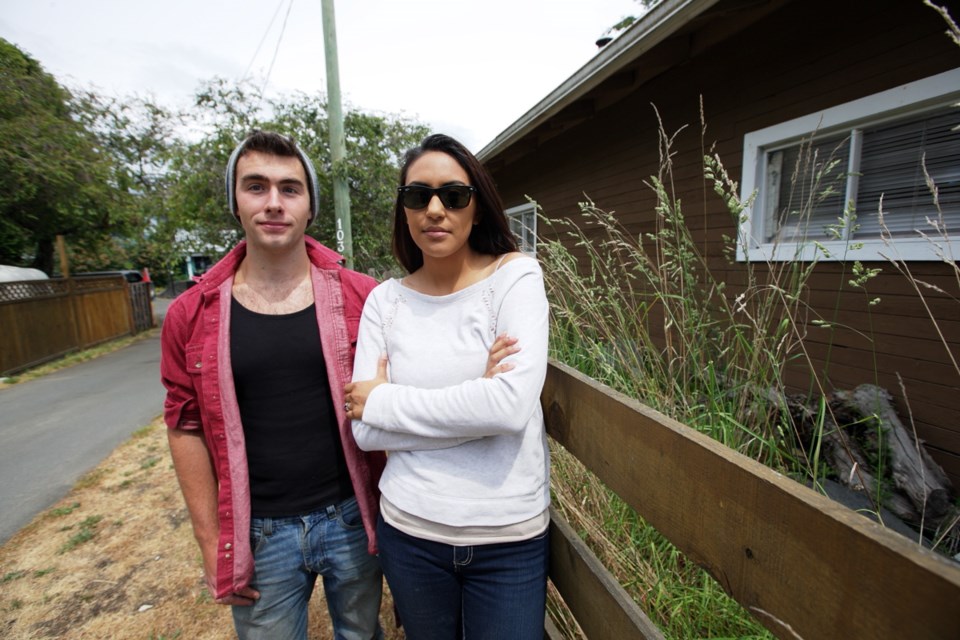Greater Victoria’s hot real estate market is making it tougher for renters to find accommodation in an already chronically tight rental climate.
Newlyweds Jordan and Abigail Burkmar of Langford are hunting for a roomier place.
“It’s been hard,” Jordan said Friday. “I emailed 10 [landlords] a few days ago and I only got one response back.”
The Burkmars scan advertisements daily in the hopes of finding an apartment or suite in a house for $800 per month by June. “We are pretty desperate for a place.”
Greater Victoria’s average apartment vacancy rate dropped to 0.6 per cent in October, down from 1.5 per cent in October 2014, according to the latest figures from Canada Mortgage and Housing Corp. The national average is 3.3 per cent.
There were 50,836 rental units of all types in the capital region, but renters and housing advocates say it isn’t enough.
Jayne Mayfield, head of the Tenant Resource and Advisory Centre in B.C., said competition is fierce for rental units. Landlords will see 30 to 40 people show up for an open house on a rental unit.
The capital region’s rental market is “really, really tight,” Mayfield said. A healthy vacancy rate would be between five and seven per cent, she said.
“We need more rental housing,” said Mayfield, who is calling for a stronger commitment from all levels of government.
Affordability is one of the biggest issues, she said. In the capital region, 34 per cent of households are renters. Of those, 47 per cent spend more than 30 per cent of their income on rent, and 24 per cent spend more than half their income on rent. That means renters at times are forced to cut back on healthy food or medications, Mayfield said.
The demand was evident on April 30, when renters lined up on Fisgard Street, down to Douglas Street to view the new 16-storey Hudson Walk One with 178 rental units.
Developers Townline and Peterson Group had 1,200 people register prior to the public viewing, said Chris Colbeck, Townline’s vice-president of sales and marketing. That’s nearly double the 650 names registered two years earlier when the 120-unit Hudson Mews rental project opened nearby.
Rents in Hudson Walk One run from $1,150 to $1,775 in the non-smoking, pet-friendly building. Units are under one-year leases.
Tenants include students, young professionals and those who are downsizing, Colbeck said. So far, more than 80 lease agreements have been signed and more are in the approval stage. There are units remaining, he said.
Factors driving rental demand include house prices which have “skyrocketed,” along with tenants moving out of older buildings and liking the idea of living downtown, Colbeck said.
Maria and Rudy Gruter are moving into the top floor of Hudson Walk One, eager to live in a unit with its own washer and dryer, and with easy access to a gym and downtown entertainment. They do not have a car and like walking.
Top-quality finishings, lots of windows and a well-designed layout are among appealing features, Maria said. “It is really like being in a condo. We will be there for a long time.”
David Hutniak, CEO of Landlord B.C. with 3,300 members, said there are some “pockets of concern” for renters, citing Victoria, Vancouver, and Kelowna.
However, he said that on a per-capita basis more rental units are being built in the capital region, much of it in or near the downtown, than in Vancouver. “That’s a positive,” said Hutniak.
As renters move into the new buildings, that will free up some of the older properties, he said.
However, Hutniak said some owners of rental properties are cashing out because they are fetching premium prices in a climate where inventory of homes for sale has severely declined, pushing prices higher.
Victoria has a “reasonable secondary market,” but renters have to look a little harder to find a place than in the past, he said.
The gap between the cost of buying and the cost of renting is a factor driving rental demand, said Canada Mortgage and Housing Corp. The benchmark price for a single-family house in the core was $684,900 last month, up by 17.7 per cent from $581,700 the previous year.
“As a result of lower vacancies, rents moved higher in 2015,” the federal agency said. The average monthly rent in a purpose-built apartment moved to $942 in October from $918 the year before. Newer rental apartments in desirable areas can command more than $1,000 per month.
Better job prospects among young adults, who tend to be renters, and the number of newcomers to the region, who may rent prior to buying, also drive the rental market, the agency said.
cjwilson @timescolonist.com



